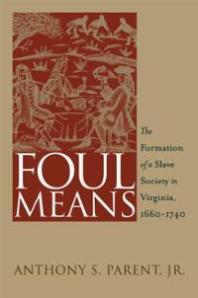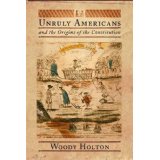 Anthony S. Parent, Foul Means: The Formation of a Slave Society in Virginia, 1660-1740 (Chapel Hill: University of North Carolina Press, 2003). Pp. 291.
Anthony S. Parent, Foul Means: The Formation of a Slave Society in Virginia, 1660-1740 (Chapel Hill: University of North Carolina Press, 2003). Pp. 291.
In Foul Means: The Formation of a Slave Society in Virginia, 1660-1740, Anthony Parent weaves a masterful account of the reasons behind the rise of slavery in Virginia between 1660 and 1740. He counters popular claims of the institution of slavery developing in early Virginia due to the tobacco production and lack of cheap labor. Instead, Parent argues that “during a brief period in the late seventeenth and early eighteenth century, a small but powerful planter class, acting in their short-term interest, gave American its racial dilemma.”[1] He claims that this emerging elite planter class conspired together to maintain and grow their power through “their decision to enslave blacks” and “establish a coercive state.”[2] As a historian of African America and Colonial America, Parent artfully responds to a collection of historians, most notably Winthrop Jordan in his work White Over Black, across time that have contended that slavery in Virginia was an “unthinking decision” creating a well defended and supported alternate viewpoint.[3]
Foul Means is outlined in three chronological and slightly overlapping sections: Origins, Conflicts, and Reactions. In the Origins section, Parent creates a character profile of what he deems the elite planter class through a social science and economic perspectives. This profile is developed through an examination of how these immigrants came to own such a large amount of land stealing and ‘buying’ it from the Native Americans, and an almost scheister group of newcomers that married into land or wealth with an eye for mercantilism. His research and graphs provide a quantitative view of his argument, allowing for a deeper understanding and a pictorial demonstration of the abuses of the colonial administration and the headright system that allowed the officials to claim slaves to gain more land.
Though Parent’s economic argument surrounding the labor shortage of indentured servants in conjunction with the rise and fall of the price of tobacco is fascinating, claiming that African enslavement quickly replaced them as a cheaper source it is merely a different perspective on an old story. The economic points Parent makes seem to wander around his main argument before coming back to center, detracting from his thesis. Shrouded in his character profile of the elite planter class, Parent discusses the initial stages of racism in America. The white indentured servants were protesting against being made ‘slaves’ which suggests that they considered slavery to be morally wrong but only when applied to themselves.[4] Thus, King Charles II “promoted the [African] slave trade” … “by protecting one labor group from exploitation”, the white English.[5] William Fitzhugh, a member of this elite planter class, discussed his notions of breeding his slaves, creating a Virginia stock, “not unlike cattle,” that could sustain their supply to meet their demand to prevent the previous labor shortage because of issues with the trading companies.[6] However, in the 1680s, the primary labor source became African slaves through various means of transport, including the black market.
The most powerful section, Conflicts, spawns from the racism laid out in Origins. The Slave Codes and laws began emerging as early as 1640, when very few Africans and free blacks lived in Virginia.[7] These Codes intended to emphasize the racism, purposely digging a valley between the whites and blacks of society, putting into law that the blacks needed to be controlled and the potential consequences if they broke these laws. Here, Parent could have demonstrated the elite planters’ knowledge of their treatment of these enslaved Africans as morally wrong, but instead he imprints the idea that the planters saw them as separate and intentionally wrote these laws to continue this separation. It is possible that these planters used this view of separateness as an excuse for their inhumane acts. The elite planters feared that the poorer whites would band together with the Africans, forming an alliance for freedom and insurgency. Interracial uprisings confirmed their fears, leading to more desperate attempts to emphasize the class difference between the two groups, such as making the slaves wear the color blue.[8] Parent details numerous revolts and attempted revolts and the quelling of their insurgency by the white elite class as a means for degradation and to prove to the rest of those planning such attempts that they would be, in effect, brought to justice. Yet these class differences were not only made apparent between lower class whites and Africans but also between the elite planters, middling and lesser planters, who some eventually were able to procure slaves for themselves. Arguments arose between the upper and lower planters and merchants over taxes imposed on the enslaved that the owners must pay. This tax would regulate the slave trade and only make elite planters financially eligible to maintain enough slaves to work the fields, thus keeping the class structure in tact with no upward movement available. However, the crown rejected the slave duty acts, much to the chagrin of the elites.
With the growing insurgency among the slaves, the poor, and other who they saw as their dependents, their loss of power with the crown in England, and their growing dependence on merchants for trade, the elite planter class devised an ideology of patriarchy to make themselves distinctive from the other classes while quelling the uprisings, as Parent explores in his final section, Reactions. Thus, as the patriarchs, these elite planters saw themselves as the top of society who provided “order, the pastoral, provincialism, and providence.”[9] As devote Anglicans, these planters founded their ideology on their faith and saw it as “divine providence” that they were the masters of the land and all the others were dutiful servants.[10] Christianity itself became an issue among the enslaved, as they saw it as a ticket for freedom; however the English saw their conversion as a means “to reduce them to greater docility.”[11] Parent discusses the corruption of the clergy and their unwillingness to usurp these patriarchal planters. An entire book could be written on the use of Christianity in slave culture by both the slaves and the white owners so the information presented is minimal but impactful.
Overall, Parent’s work is an interesting perspective on slavery and class development in early Virginia. He supports and proves his arguments both that an elite planter class emerged through coercion and illegal landing dealings via political standings and connections and also that this elite planter class conspired to switch labor sources from indentured servants to African slaves. Parent’s research into statistics of the landholdings and headright patents as well as his use of journals and letters only strengthen this argument. His differing perspectives surrounding this ethnohistory are a welcome change from the standard cultural and social perspectives surrounding the investigation into slavery. In spite of sporadic moments where Parent digresses slightly the organization of the book allows for an easy reading flow, from reviewing and understanding base information, such as the slave code, and then analyzing interaction and reaction to this information, such as the uprisings and conflicts.
However, the information that Parent presents is hardly new to the field. The contribution Foul Means makes to the historiographic conversation is the viewpoint of the argument. Even if other historians do not agree with his conclusions, Parent expands the conversation to include this elite planter class that cannot be denied based upon his research and presentation.
[1] Anthony S. Parent, Foul Means: The Formation of a Slave Society in Virginia, 1660-1740 (Chapel Hill, NC: University of North Carolina Press, 2003), pp. 2.
[2] Parent, pp. 105.
[3] Winthrop D. Jordan, White Over Black: American Attitudes Toward the Negro, 1550-1812 (Chapel Hill, NC: University of North Carolina Press, 1968), pp. 44-98; Parent, pp. 2.
[4] Parent, pp. 56.
[5] Parent, pp. 60.
[6] Parent, pp. 72.
[7] Parent, pp. 109.
[8] Parent, 147.
[9] Parent, 200.
[10] Parent, 236, 201.
[11] Parent, 237-8.


